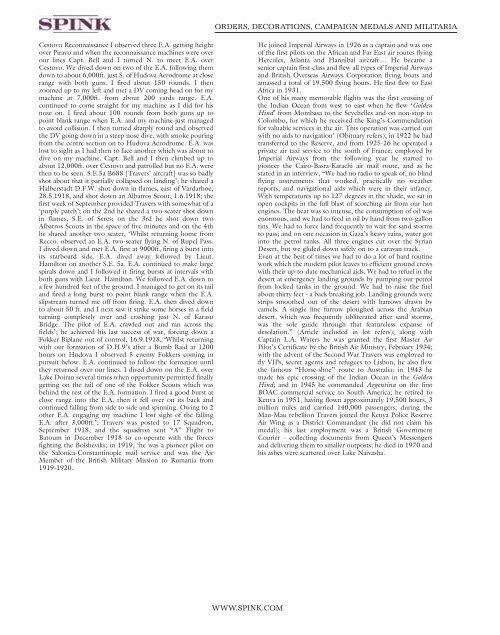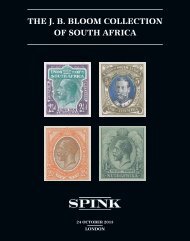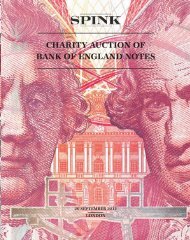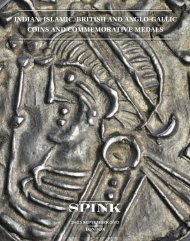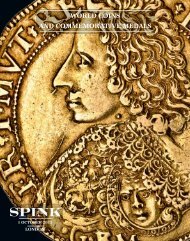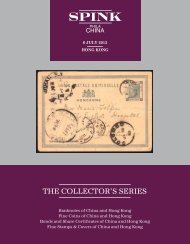orders, decorations, campaign medals and militaria - Spink
orders, decorations, campaign medals and militaria - Spink
orders, decorations, campaign medals and militaria - Spink
You also want an ePaper? Increase the reach of your titles
YUMPU automatically turns print PDFs into web optimized ePapers that Google loves.
Cestovo Reconnaissance I observed three E.A. getting height<br />
over Piravo <strong>and</strong> when the reconnaissance machines were over<br />
our lines Capt. Bell <strong>and</strong> I turned N. to meet E.A. over<br />
Cestovo. We dived down on two of the E.A. following them<br />
down to about 6,000ft. just S. of Hudova Aerodrome at close<br />
range with both guns. I fired about 150 rounds. I then<br />
zoomed up to my left <strong>and</strong> met a DV coming head on for my<br />
machine at 7,000ft. from about 200 yards range. E.A.<br />
continued to come straight for my machine as I did for his<br />
nose on. I fired about 100 rounds from both guns up to<br />
point blank range when E.A. <strong>and</strong> my machine just managed<br />
to avoid collision. I then turned sharply round <strong>and</strong> observed<br />
the DV going down in a steep nose dive, with smoke pouring<br />
from the centre section on to Hudova Aerodrome. E.A. was<br />
lost to sight as I had then to face another which was about to<br />
dive on my machine. Capt. Bell <strong>and</strong> I then climbed up to<br />
about 12,000ft. over Cestovo <strong>and</strong> patrolled but no E.A. were<br />
then to be seen. S.E.5a B688 [Travers’ aircraft] was so badly<br />
shot about that it partially collapsed on l<strong>and</strong>ing’; he shared a<br />
Halberstadt D.F.W. shot down in flames, east of Vardarhoe,<br />
28.5.1918, <strong>and</strong> shot down an Albatros Scout, 1.6.1918; the<br />
first week of September provided Travers with somewhat of a<br />
‘purple patch’; on the 2nd he shared a two-seater shot down<br />
in flames, S.E. of Seres; on the 3rd he shot down two<br />
Albatros Scouts in the space of five minutes <strong>and</strong> on the 4th<br />
he shared another two seater, ‘Whilst returning home from<br />
Recco. observed an E.A. two-seater flying N. of Rupel Pass.<br />
I dived down <strong>and</strong> met E.A. first at 9000ft, firing a burst into<br />
its starboard side. E.A. dived away followed by Lieut.<br />
Hamilton on another S.E. 5a. E.A. continued to make large<br />
spirals down <strong>and</strong> I followed it firing bursts at intervals with<br />
both guns with Lieut. Hamilton. We followed E.A. down to<br />
a few hundred feet of the ground. I managed to get on its tail<br />
<strong>and</strong> fired a long burst to point blank range when the E.A.<br />
slipstream turned me off from firing. E.A. then dived down<br />
to about 50 ft. <strong>and</strong> I next saw it strike some horses in a field<br />
turning completely over <strong>and</strong> crashing just N. of Karasu<br />
Bridge. The pilot of E.A. crawled out <strong>and</strong> ran across the<br />
fields’; he achieved his last success of war, forcing down a<br />
Fokker Biplane out of control, 16.9.1918, ‘Whilst returning<br />
with our formation of D.H.9’s after a Bomb Raid at 1200<br />
hours on Hudova I observed 5 enemy Fokkers coming in<br />
pursuit below. E.A. continued to follow the formation until<br />
they returned over our lines. I dived down on the E.A. over<br />
Lake Doiran several times when opportunity permitted finally<br />
getting on the tail of one of the Fokker Scouts which was<br />
behind the rest of the E.A. formation. I fired a good burst at<br />
close range into the E.A. then it fell over on its back <strong>and</strong><br />
continued falling from side to side <strong>and</strong> spinning. Owing to 2<br />
other E.A. engaging my machine I lost sight of the falling<br />
E.A. after 3,000ft.’; Travers was posted to 17 Squadron,<br />
September 1918, <strong>and</strong> the squadron sent “A” Flight to<br />
Batoum in December 1918 to co-operate with the forces<br />
fighting the Bolsheviks; in 1919, ‘he was a pioneer pilot on<br />
the Salonica-Constantinople mail service <strong>and</strong> was the Air<br />
Member of the British Military Mission to Rumania from<br />
1919-1920.<br />
<strong>orders</strong>, deCoratioNs, CampaigN medaLs aNd miLitaria<br />
WWW.spiNK.Com<br />
He joined Imperial Airways in 1926 as a captain <strong>and</strong> was one<br />
of the first pilots on the African <strong>and</strong> Far East air routes flying<br />
Hercules, Atlanta <strong>and</strong> Hannibal aircraft.... He became a<br />
senior captain first-class <strong>and</strong> flew all types of Imperial Airways<br />
<strong>and</strong> British Overseas Airways Corporation flying boats <strong>and</strong><br />
amassed a total of 19,500 flying hours. He first flew to East<br />
Africa in 1931.<br />
One of his many memorable flights was the first crossing of<br />
the Indian Ocean from west to east when he flew ‘Golden<br />
Hind’ from Mombasa to the Seychelles <strong>and</strong> on non-stop to<br />
Colombo, for which he received the King’s Commendation<br />
for valuable services in the air. This operation was carried out<br />
with no aids to navigation’ (Obituary refers); in 1922 he had<br />
transferred to the Reserve, <strong>and</strong> from 1925-26 he operated a<br />
private air taxi service to the south of France; employed by<br />
Imperial Airways from the following year he started to<br />
pioneer the Cairo-Basra-Karachi air mail route, <strong>and</strong> as he<br />
stated in an interview, “We had no radio to speak of, no blind<br />
flying instruments that worked, practically no weather<br />
reports, <strong>and</strong> navigational aids which were in their infancy.<br />
With temperatures up to 127 degrees in the shade, we sat in<br />
open cockpits in the full blast of scorching air from our hot<br />
engines. The heat was so intense, the consumption of oil was<br />
enormous, <strong>and</strong> we had to feed in oil by h<strong>and</strong> from two-gallon<br />
tins. We had to force l<strong>and</strong> frequently to wait for s<strong>and</strong> storms<br />
to pass; <strong>and</strong> on one occasion in Gaza’s heavy rains, water got<br />
into the petrol tanks. All three engines cut over the Syrian<br />
Desert, but we glided down safely on to a caravan track.<br />
Even at the best of times we had to do a lot of hard routine<br />
work which the modern pilot leaves to efficient ground crews<br />
with their up-to-date mechanical aids. We had to refuel in the<br />
desert at emergency l<strong>and</strong>ing grounds by pumping our petrol<br />
from locked tanks in the ground. We had to raise the fuel<br />
about thirty feet - a back breaking job. L<strong>and</strong>ing grounds were<br />
strips smoothed out of the desert with harrows drawn by<br />
camels. A single line furrow ploughed across the Arabian<br />
desert, which was frequently obliterated after s<strong>and</strong> storms,<br />
was the sole guide through that featureless expanse of<br />
desolation.” (Article included in lot refers); along with<br />
Captain L.A. Waters he was granted the first Master Air<br />
Pilot’s Certificate by the British Air Ministry, February 1934;<br />
with the advent of the Second War Travers was employed to<br />
fly VIPs, secret agents <strong>and</strong> refugees to Lisbon, he also flew<br />
the famous “Horse-shoe” route to Australia; in 1943 he<br />
made his epic crossing of the Indian Ocean in the Golden<br />
Hind; <strong>and</strong> in 1945 he comm<strong>and</strong>ed Argentina on the first<br />
BOAC commercial service to South America; he retired to<br />
Kenya in 1951, having flown approximately 19,500 hours, 3<br />
million miles <strong>and</strong> carried 140,000 passengers; during the<br />
Mau-Mau rebellion Travers joined the Kenya Police Reserve<br />
Air Wing as a District Comm<strong>and</strong>ant (he did not claim his<br />
medal); his last employment was a British Government<br />
Courier - collecting documents from Queen’s Messengers<br />
<strong>and</strong> delivering them to smaller outposts; he died in 1970 <strong>and</strong><br />
his ashes were scattered over Lake Naivasha.


